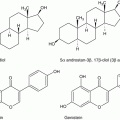© International Society of Gynecological Endocrinology 2016
Andrea R. Genazzani and Basil C. Tarlatzis (eds.)Frontiers in Gynecological EndocrinologyISGE Series10.1007/978-3-319-23865-4_1212. Androgen Replacement in Women: Safe and Efficacious?
(1)
Department of West London Menopause Service, Nick Panay Queen Charlotte’s & Chelsea and Chelsea & Westminster Hospitals, Imperial College London, London, UK
There has been a considerable amount of controversy over the last few years as to the precise role of endogenous androgens in women and the place of exogenous androgen replacement in women with distressing low sexual desire. What is not in dispute is that healthy young women produce approximately 100–400 mcg per day. This represents three to four times the amount of estrogen produced by the ovaries. Approximately half the endogenous testosterone and precursors are derived from the ovaries and half from the adrenal glands.
Testosterone contributes to sexual desire, arousal, and orgasm; clearly, there are other factors involved including psychosexual, physical, iatrogenic, and environmental. It has been postulated that the decline in testosterone levels, which occurs throughout a woman’s lifespan [1] and particularly so after a surgical menopause when testosterone production decreases by 50 % within days of the surgery, can lead to a number of distressing symptoms (not just sexual) including reduction in well-being, energy levels, and mood. Additionally, there appears to be a synergistic effect of testosterone with estrogen in maintaining bone and muscle mass [2].
In view of these apparently important functions of endogenous testosterone, it is perhaps surprising that there has been so little research into the sequelae of deficiency (ironically less so than research into conditions of excess androgens such as polycystic ovarian syndrome). Equally surprising has been the dearth of development of products specifically targeted at female androgen replacement. In the absence of research and development in these fundamental areas, it is not surprising that many women and practitioners still perceive testosterone as an entirely male hormone and testosterone replacement entirely within the domain of the andrologist. There is also a considerable amount of suspicion that this “male” hormone is worthy of consideration of replacement in women with an apparent deficiency state. There are even accusations that low libido states have been invented by husbands, male physicians, or pharmaceutical companies hoping to capitalize on this “pseudo condition” with expensive drugs.
The immediate reaction of both patients and practitioners alike is “what are the risks” with concerns of hyperandrogenism, e.g., hirsutism, cardiovascular disease, and breast cancer usually at the top of the list. Concerns regarding side effects and long-term adverse events seem to ignore the following fact: genuine testosterone replacement aims to replace the deficiency, not to create supra-physiological levels. Women do not develop symptoms and signs of hyperandrogenism if levels are kept within the physiological range. There are no convincing prospective randomized data of physiological testosterone replacement showing an association with cardiovascular or breast disease. The observational data from the nurses’ health study [3] (in which uncontrolled use of various androgen preparations occurred) suggesting an increased risk are counterbalanced by other studies suggesting there may even be a benefit [4]. The small number of excess breast cancer cases reported in a transdermal testosterone study is likely to have been due to chance in a study not powered to look at this as a major outcome measure [5]. However, the current philosophy of the regulatory authorities with regard to testosterone and the potential for adverse events seems to be that absence of evidence for long-term harm is not evidence of absence.
One of the difficulties in the development of these products has been the lack of consistently accepted and validated rating scales for libido and quality of life. There have been concerns about some of the more recently developed questionnaires (accepted by the American Psychiatric Association) because of the involvement of pharmaceutical companies. It is my view that these prejudices are stifling the development of validated tools of assessment and the subsequent development of appropriate products for the treatment of a group of women who have a genuine deficiency state. Averaged outcomes from the small randomized trials conducted thus far have not been striking, yet these treatments, appropriately targeted in the clinical situation, can have life-transforming effects. Women who particularly seem to benefit are those young surgically or otherwise iatrogenically menopausal who feel persistently tired and lacking in libido despite adequate estrogen therapy. Androgen replacement appears to give them back their zest for life, or better still, their “joie de vivre” [6].
So what is available to women and their physicians? The implanted pellets of testosterone were available in a number of countries for many decades, with some notable exceptions (e.g., the USA). While being a convenient and highly effective way of replacing both estrogen and testosterone over periods of 6 months [7], these pellets tied the patient to her physician, lacked flexibility to change the dosage and delivered, in the standard 100-mg pellet, supraphysiological levels of testosterone. These pellets are no longer available in a licensed formulation purely for commercial reasons, leaving many women who have failed androgen therapy with other options in a very difficult position. This has opened the door to compounding pharmacists with concerns about the quality, consistency, efficacy, and safety of their androgenic products.
Stay updated, free articles. Join our Telegram channel

Full access? Get Clinical Tree




